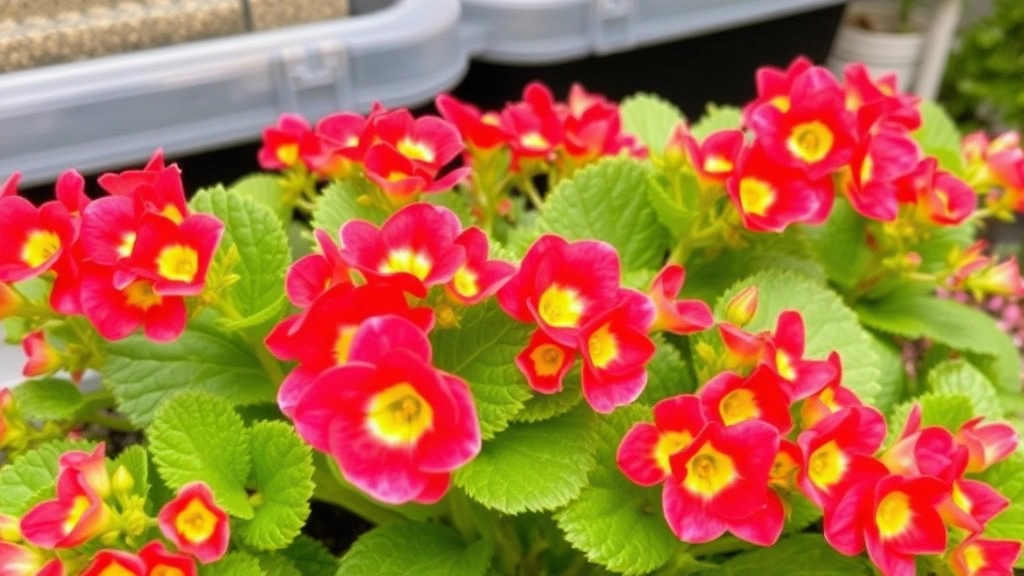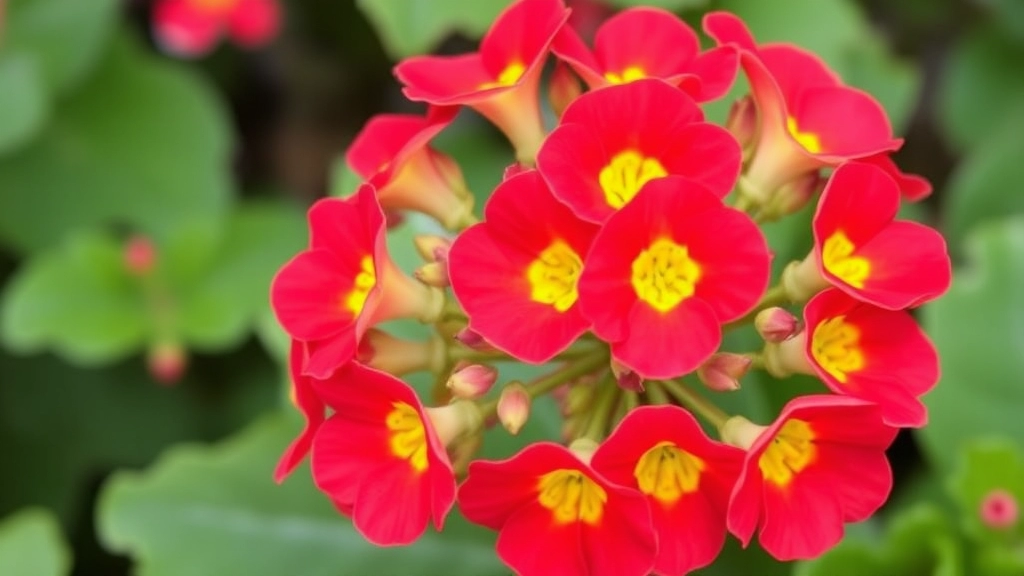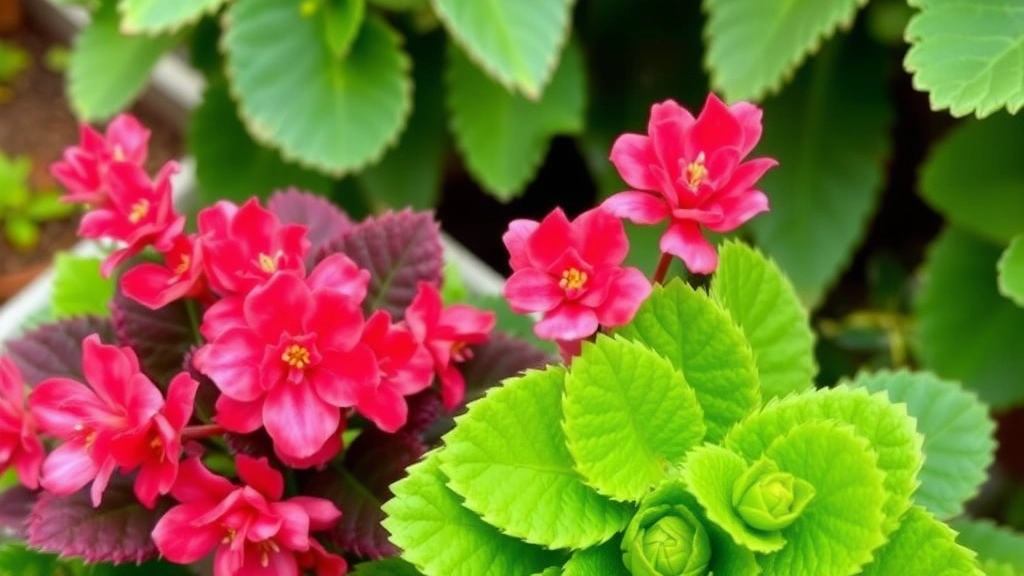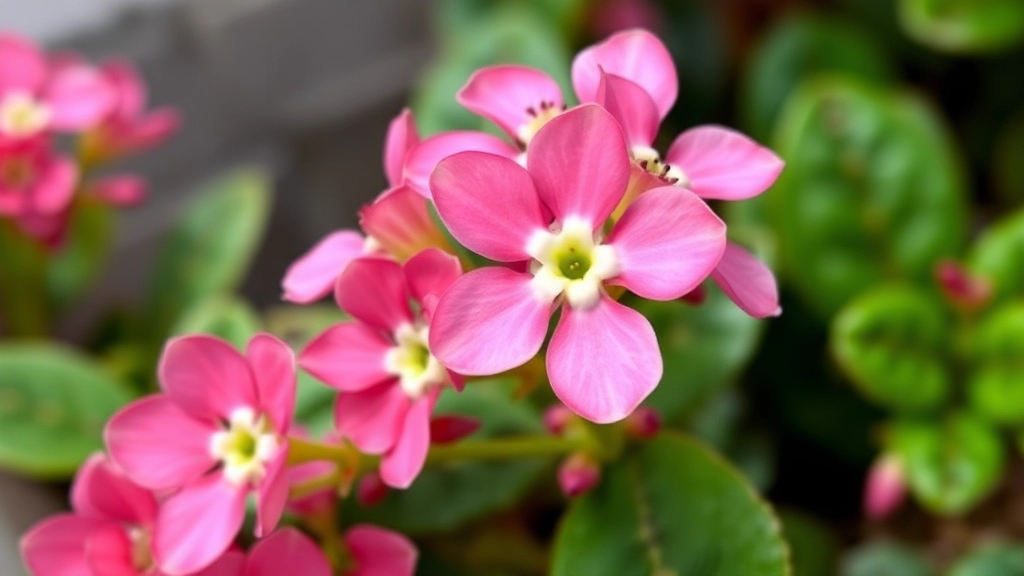Flowering Succulents: Kalanchoe Species
When it comes to flowering succulents, the Kalanchoe species stand out for their vibrant blooms and low-maintenance care. Whether you’re a gardening newbie or a seasoned succulent collector, understanding the different types of Kalanchoe can transform your indoor or outdoor garden. In this article, we’ll dive into the popular Kalanchoe varieties, their growth patterns, and essential care tips to keep your plants thriving.
From the common Kalanchoe blossfeldiana to the rare and exotic species, each type offers unique beauty and charm. We’ll explore the best Kalanchoe species for indoor cultivation, how to propagate them, and tackle common issues you might face. By the end, you’ll be well-equipped to design a stunning garden with these versatile succulents. Let’s get started on your journey to mastering the care of Flower Kalanchoe Species!
Popular Kalanchoe Varieties for Beginners
Are you new to the world of Kalanchoe and unsure where to start? You’re not alone. Many beginners face the challenge of choosing the right varieties that are not only easy to care for but also rewarding to grow.
Kalanchoe plants offer a delightful mix of beauty and resilience, making them perfect for novice gardeners. Here are some popular varieties that you might consider:
1. Kalanchoe Blossfeldiana
- Description: This is perhaps the most common Kalanchoe variety, known for its vibrant clusters of flowers.
- Care Tips: Requires bright light and minimal watering. Ideal for beginners due to its hardiness.
2. Kalanchoe Tomentosa (Panda Plant)
- Description: Recognised for its fuzzy, silvery leaves with a hint of red on the edges.
- Care Tips: Thrives in indirect sunlight and needs minimal water, making it a low-maintenance choice.
3. Kalanchoe Fedtschenkoi (Chandelier Plant)
- Description: Features unique, elongated leaves that dangle like chandeliers.
- Care Tips: Prefers well-drained soil and moderate watering. A great option for those looking to add character to their collection.
4. Kalanchoe Luciae (Flapjack Plant)
- Description: Known for its large, flat leaves that can turn vibrant red under stress.
- Care Tips: Enjoys full sun and infrequent watering, making it a striking yet simple addition.
5. Kalanchoe Pinnata (Air Plant)
- Description: This variety can propagate easily from its leaves, making it fascinating for beginners.
- Care Tips: Thrives in bright light and requires little water, perfect for those wanting a plant that grows effortlessly.
These varieties are not only visually appealing but also forgiving when it comes to care, making them ideal for those just starting their gardening journey. For more detailed information on specific types, check out this Kalanchoe Succulent Identification Guide and if you’re interested in the unique Chandelier Plant, our Chandelier Plant Care Guide is a must-read.
Understanding the Growth Patterns of Flowering Kalanchoes

Have you ever wondered why your Kalanchoe plants seem to have a mind of their own?
Understanding their growth patterns can really help you nurture them better.
Growth Cycle Insights
Flowering Kalanchoes have distinct growth cycles that can be fascinating to observe.
- Active Growth Phase: Typically, these beauties thrive in spring and summer. During this time, they’ll grow rapidly and may produce stunning flowers.
- Resting Phase: Come autumn and winter, they slow down. This is normal! They’re conserving energy, so don’t be alarmed if they seem less vibrant.
Flowering Patterns
Let’s talk about those gorgeous blooms!
- Flowering Triggers: Kalanchoes bloom based on light exposure. They need around 14 hours of darkness to kickstart flowering.
- Duration of Blooms: Once they start flowering, expect blooms to last for several weeks. After this, they may need a little time to recharge before blooming again.
Growth Habits
- Height and Spread: Most Kalanchoes grow between 12-18 inches tall. They can spread out, too, so give them space to breathe!
- Leaf Development: Watch for plump, fleshy leaves. They store water, making these plants drought-resistant.
Tips for Observing Growth
- Daily Check-ins: Spend a few minutes each day observing your Kalanchoes. You’ll notice changes that can guide your care routine.
- Light and Position: Adjust their position based on sunlight exposure. Too little light can hinder growth, while too much can scorch those lovely leaves.
Best Kalanchoe Species for Indoor Cultivation
When considering which Kalanchoe species to bring into your home, you might wonder which ones thrive best indoors.
Kalanchoe blossfeldiana
- Vibrant Flowers: Known for its stunning clusters of flowers in various colours, it can bloom multiple times a year.
- Care: Requires bright, indirect sunlight and minimal watering. For more detailed care tips, check out our guide on growing and caring for flowering Kalanchoe blossfeldiana.
Kalanchoe tomentosa
- Low Maintenance: It thrives in average household conditions.
- Aesthetic Appeal: Its striking appearance adds a touch of whimsy to any space. Learn more about its care and propagation in our Kalanchoe tomentosa propagation guide.
Kalanchoe luciae
- Sunlight Needs: Prefers bright light for optimal colour.
- Watering: Less frequent watering is needed, making it a great choice for beginners.
Kalanchoe beharensis
- Unique Texture: Adds a dramatic element to your indoor garden.
- Growth: Can reach heights of up to 3 feet, so ensure you have enough space.
Kalanchoe ‘Fang’
- Distinctive Look: Perfect for those looking to add an unusual plant to their collection.
- Care: Similar care requirements to other Kalanchoe species, making it easy to manage.
How to Care for Kalanchoe Succulents: Tips for Optimal Growth

Caring for Kalanchoe succulents can feel daunting, especially for beginners. But with the right approach, you can cultivate these vibrant plants effortlessly.
Key Care Tips for Kalanchoe Succulents:
- Light Requirements:
Kalanchoes thrive in bright, indirect sunlight.
A south-facing window is ideal.
Too much direct sunlight can scorch their leaves. - Watering Schedule:
Allow the soil to dry out completely between waterings.
Typically, watering every two to three weeks suffices.
Overwatering is a common mistake; ensure pots have drainage holes. - Soil Type:
Use a well-draining succulent mix.
You can also create your own by mixing regular potting soil with sand or perlite. - Temperature and Humidity:
Kalanchoes prefer temperatures between 18°C to 24°C.
They can tolerate lower temperatures but avoid frost.
Low humidity levels are best, as they originate from arid environments. - Fertilising:
Feed your Kalanchoe with a balanced, diluted fertiliser during the growing season.
This typically spans from spring to early autumn.
Skip fertilising in winter when the plant is dormant. - Pruning and Deadheading:
Regularly remove dead leaves and spent flowers.
This encourages new growth and keeps the plant healthy.
As we explore the captivating world of Kalanchoe, it’s essential to highlight some rare and exotic species that can truly elevate your collection. For many enthusiasts, the thrill of discovering unique plants is what keeps the passion alive.
### Notable Rare Kalanchoe Species
– **Kalanchoe marmorata**
– Also known as the **Panda Plant**, this species features striking, spotted leaves.
– Its unique appearance makes it a conversation starter.
– **Kalanchoe beharensis**
– Commonly referred to as the **Elephant Ear Plant**, this variety boasts large, textured leaves.
– It can grow quite tall, adding an impressive vertical element to your collection.
– **Kalanchoe luciae**
– Known as **Flapjack Plant**, its vibrant, pancake-like leaves change colour with the seasons.
– A real visual treat, especially in bright sunlight.
– **Kalanchoe thyrsiflora**
– This species is often called the **Mother of Thousands** due to its ability to produce numerous offsets.
– It’s a fantastic choice for propagation enthusiasts.
– **Kalanchoe tomentosa**
– Commonly known as **Panda Plant**, it features fuzzy, grey-green leaves with brown edges.
– Its unique texture and colour make it a standout in any collection.
### Why Collect Rare Kalanchoe?
– **Aesthetic Appeal**: Unique shapes and colours can enhance your indoor or outdoor space.
– **Conversation Starters**: Rare species often draw attention and spark discussions.
– **Cultivation Challenges**: For those who thrive on challenges, caring for rare varieties can be rewarding.
### Tips for Collecting
– **Research**: Understand the specific needs of each species before adding them to your collection.
– **Source Wisely**: Purchase from reputable nurseries or online retailers to ensure healthy plants.
– **Join Communities**: Engage with fellow collectors through forums or social media for tips and trade opportunities.
For those interested in learning more about the care and propagation of specific Kalanchoe species, check out our [Kalanchoe Mother of Thousands Care Guide](https://planthq.org/complete-guide-to-kalanchoe-mother-of-thousands-care-propagation/) and our detailed [Kalanchoe Tomentosa Propagation Guide](https://planthq.org/kalanchoe-tomentosa-propagation-guide-stepbystep-tips/).
Kalanchoe Flowering Seasons: What to Expect

So, you’ve got your Kalanchoe and you’re eager to see those vibrant blooms. But when exactly can you expect them to flower?
Understanding Flowering Seasons
Kalanchoes are known for their stunning flowers, and knowing their flowering seasons can really enhance your gardening experience. Here’s what you should keep in mind:
- Winter to Spring: Most Kalanchoe varieties bloom between late winter and early spring. This is when they show off their colourful flowers, making them perfect for brightening up those chilly months.
- Summer Dormancy: After their initial blooming period, many Kalanchoes enter a dormancy phase during the summer. You might notice fewer flowers or even a complete stop in blooming. Don’t worry; this is totally normal!
- Second Blooming: Some species may surprise you with a second round of blooms in the fall. However, this isn’t guaranteed for all varieties.
Factors Influencing Flowering
Several factors can impact when and how your Kalanchoe flowers:
- Light Exposure: Kalanchoes love bright, indirect sunlight. Insufficient light can delay blooming.
- Temperature: They thrive in temperatures between 18-24°C (65-75°F). Extreme heat or cold can affect their flowering cycle.
- Watering: Overwatering can lead to root rot, which might hinder blooming. Stick to a schedule that allows the soil to dry out between waterings.
Tips for Encouraging Blooms
Want to encourage your Kalanchoe to flower? Here are some simple tips:
- Pruning: After blooming, prune spent flowers to encourage new growth.
- Fertilizing: Use a balanced fertiliser during the growing season to boost blooms.
- Stress: Believe it or not, a little stress can encourage flowering. Reducing watering slightly before the blooming season can help.
Propagation Methods for Different Kalanchoe Types
When it comes to expanding your Kalanchoe collection, many enthusiasts wonder about the best propagation methods.
Common Issues with Kalanchoe and How to Solve Them

So, you’ve got your Kalanchoe thriving, but suddenly you spot some issues. What gives?
Kalanchoes are pretty resilient, but they can face a few hiccups along the way. Here are some common problems and how to tackle them.
1. Overwatering
- Signs: Yellowing leaves, mushy stems.
- Solution: Let the soil dry out completely before watering again. Use a pot with good drainage.
2. Underwatering
- Signs: Wrinkled leaves, drooping.
- Solution: Water thoroughly until it drains out the bottom. Keep a regular schedule, especially during hot spells.
3. Pests
- Signs: Sticky residue, webbing, or visible bugs.
- Solution: Wipe leaves with a damp cloth. For heavier infestations, use insecticidal soap or neem oil.
4. Leaf Drop
- Signs: Leaves falling off, especially lower ones.
- Solution: Check for stress factors like temperature changes or sudden light exposure.
5. Poor Flowering
- Signs: Sparse blooms or no flowers at all.
- Solution: Ensure it gets enough light (at least 6 hours of bright indirect sunlight) and consider a balanced fertiliser during the growing season.
6. Fungal Issues
- Signs: Dark spots or mouldy patches on leaves.
- Solution: Improve airflow around the plant and avoid overhead watering. Remove affected leaves immediately.
7. Leggy Growth
- Signs: Stretched stems, sparse leaves.
- Solution: Rotate your plant regularly to ensure even light exposure. Prune back any leggy stems to encourage bushier growth.
With these tips, you can keep your Kalanchoe looking its best.
When it comes to designing a garden, many of us often wonder how to create a vibrant and low-maintenance space. Kalanchoe succulents can be a fantastic addition, offering both beauty and resilience.
### Choosing the Right Location
Before you start planting, consider the following:
– **Sunlight:** Kalanchoes thrive in bright, indirect sunlight. Choose a spot that receives at least six hours of light daily.
– **Soil:** Well-draining soil is essential. A cactus mix or a blend of potting soil with sand works wonders.
– **Space:** Kalanchoes can grow quite large, so ensure they have enough room to spread out without overcrowding.
### Design Ideas for Your Kalanchoe Garden
Here are some creative ideas to incorporate Kalanchoe into your garden:
– **Borders and Edges:** Use Kalanchoe as a border plant along pathways or garden beds. Their vibrant colours can create a stunning visual effect.
– **Rock Gardens:** Pair Kalanchoe with rocks and pebbles for a natural look. The contrast between the hardscape and the succulent’s softness is visually appealing.
– **Container Gardens:** If space is limited, consider planting Kalanchoe in pots. You can mix different varieties for a colourful display.
### Maintenance Tips
To keep your Kalanchoe garden thriving:
– **Watering:** Allow the soil to dry out between waterings. Overwatering can lead to root rot.
– **Fertilising:** Use a balanced fertiliser during the growing season to encourage blooming.
– **Pruning:** Regularly remove dead leaves and spent flowers to promote new growth.
For more specific care tips, you might want to check out the [ultimate guide to growing and caring for succulent plant Kalanchoe](https://planthq.org/ultimate-guide-to-growing-and-caring-for-succulent-plant-kalanchoe/) and learn about the [best soil for Kalanchoe Blossfeldiana care](https://planthq.org/best-soil-for-kalanchoe-blossfeldiana-care-tips/).
FAQs on Flowering Kalanchoe Species
What are the growth phases of flowering Kalanchoes?
Flowering Kalanchoes have two main growth phases:
- Active Growth Phase: Occurs in spring and summer, where the plant grows rapidly and may produce flowers.
- Resting Phase: Happens in autumn and winter, where the plant conserves energy and growth slows down.
How do Kalanchoes trigger flowering?
Kalanchoes bloom based on light exposure. They need approximately 14 hours of darkness to initiate flowering.
How long do Kalanchoe blooms last?
Once Kalanchoes start flowering, the blooms can last for several weeks. Afterward, the plant may need some time to recharge before blooming again.
What are the typical height and spread of Kalanchoe plants?
Most Kalanchoes grow between 12-18 inches tall. They can also spread out, so it’s essential to provide them with enough space.
How should I care for Kalanchoe succulents?
Here are some key care tips:
- Light: Bright, indirect sunlight is ideal. Avoid too much direct sunlight.
- Watering: Allow the soil to dry out completely between waterings, typically every two to three weeks.
- Soil: Use a well-draining succulent mix or mix regular potting soil with sand or perlite.
- Temperature: Prefer temperatures between 18°C to 24°C. Avoid frost.
- Fertilizing: Use a balanced, diluted fertilizer during the growing season (spring to early autumn).
- Pruning: Regularly remove dead leaves and spent flowers to encourage new growth.
When do Kalanchoes typically flower?
Most Kalanchoe varieties bloom between late winter and early spring. Some may enter a dormancy phase in summer and possibly have a second blooming in the fall.
What factors influence Kalanchoe flowering?
Several factors can impact flowering:
- Light Exposure: Bright, indirect sunlight is crucial.
- Temperature: Optimal range is 18-24°C (65-75°F).
- Watering: Proper watering schedule to avoid root rot.
How can I encourage my Kalanchoe to bloom?
To encourage blooming:
- Pruning: Prune spent flowers to promote new growth.
- Fertilizing: Use a balanced fertilizer during the growing season.
- Stress: Slightly reducing watering before the blooming season can help.
What are common issues with Kalanchoes and how can I solve them?
Common issues include:
- Overwatering: Signs include yellowing leaves and mushy stems. Solution: Let the soil dry out completely before watering again.
- Underwatering: Signs include wrinkled leaves and drooping. Solution: Water thoroughly and maintain a regular schedule.
- Pests: Signs include sticky residue, webbing, or visible bugs. Solution: Wipe leaves with a damp cloth or use insecticidal soap or neem oil for infestations.
- Leaf Drop: Signs include leaves falling off, especially lower ones. Solution: Check for stress factors like temperature changes or sudden light exposure.
- Poor Flowering: Signs include sparse blooms or no flowers. Solution: Ensure adequate light and consider using a balanced fertilizer during the growing season.
- Fungal Issues: Signs include dark spots or moldy patches on leaves. Solution: Improve airflow and avoid overhead watering. Remove affected leaves immediately.
- Leggy Growth: Signs include stretched stems and sparse leaves. Solution: Rotate the plant regularly for even light exposure and prune leggy stems for bushier growth.
References
-
How to Grow Kalanchoe Succulents
-
Kalanchoe Plant Care: Growing Kalanchoe Succulent Plants
-
Kalanchoe: How to Grow and Care for Kalanchoe Plants
